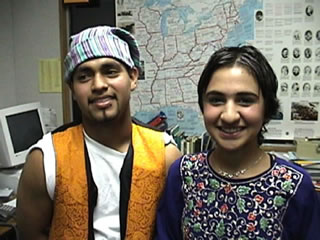Resources
I have a couple of books by Viola
Spolin, they’re
really good, and not just for professionals, they’re for
classroom teachers, community theater groups, people who’ve
never acted before. And there are a lot of books like that,
theater games, anytime I see a book I peruse it to try to steal
stuff. Those games are really good, you just morph them into what
you need.
I also use adaptations, anything pertaining
to theater. Scripts, adaptations, how-to-books, design
books, you go to Samuel
French on Sunset Blvd and they’ll help you. They’re
knowledgeable, mostly actors, directors, people who love theater
and it’s
their day job. If you go there, you can spend hours in
the stacks. The adaptations I use are generally
45 minutes to an hour. Most of them are middle school level,
which is where my transition kids are at, although the first year
we used an edition of "Comedy of Errors" called the Globe
Edition, from the 30’s,
and that’s actually all iambic pentameter—it’s
all Shakespeare, and all they did in that was pare down speeches. So
if there’s a speech that’s 1/8th plot and the rest
is figurative language, and description, then they excise the description
and leave the plot lines, so they’ve been able to cut it
down to 45 minutes. Actually, that’s what we mastered that
first year. The adaptations we’ve been using the
last two years are more middle school, they keep some of the
syntax, but it’s really been simplified. They keep some of
the famous lines, but they’re easier to get into 45 minutes,
and then I can add dances, and a prologue and an epilogue. I
need to really keep it to about 70 minutes. Usually, at this point
it takes about 2 ½ minutes to break down the room
and set up the theater, and 2 ½ minutes to set it back up.
But as you get close to opening, then you’re dealing with
getting your costumes on and off, so, 70 minutes is about the max.
To introduce each play, I generally start with Charles
and Mary Lamb's “Tales from Shakespeare”. We also
use critical material, which you can get in the library and online. Sometimes
I look at Harbage,
sometimes I look online and remember names of literary critics
from when I was in college. Jan
Kott or 20th
century views will sometimes have a casebook of a particular
play, maybe 10 scholars, so sometimes I’ll try
to find that. I
like theater reviews, too, so at the UCSB library
I’ll
look at the NY Times, which goes back to the 1920’s,
and look at Brook Atkinson, some of those—he was great,
a meat and potatoes reviewer. He was their reviewer
from the 40’s
and 50’s. Walter Kerr, another great reviewer. But
they’re all marvelous. Some of them have a slant
one way or another, but, that’s really fun, and I’ll
show that to the kids, so that they know as college scholars,
reviews are a nice way to get a quick hit on the play. It’s
not enough, but you get ideas for how it’s been staged,
and what a particular audience saw. And you can get
reviews online, too, for college productions.
Professional Organizations
Since I've been a teacher, I’ve let many of my associations
with acting go– I have my SAG union and Equity card, and
I'm a former member of AFTRA and the TV Academy. My main
professional affiliation is SCWriP,
the South Coast Writing Project. I'm also affiliated with UCSB's
Center for Teaching for Social Justice, and usually I do something
every summer with them. Those are my professional associations. I
like to do some acting, but I’m so busy—maybe somewhere
down the road.
